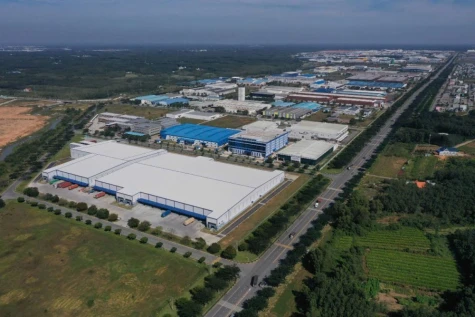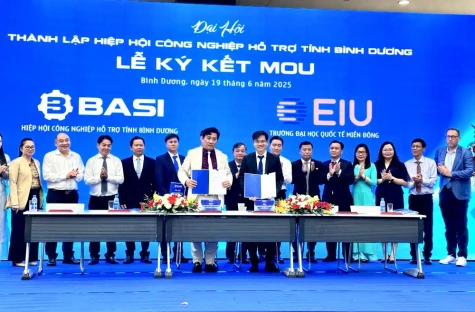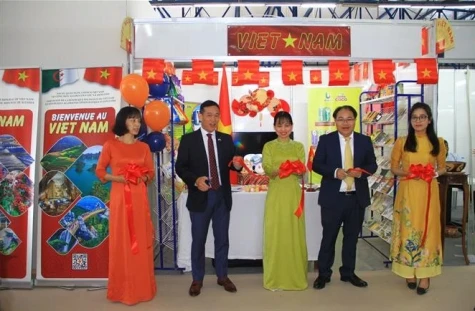In the first months of 2025, textile and garment enterprises in Binh Duong province are receiving positive signals with a large and stable number of orders. They expect to achieve significant growth this year and expand their export markets.

Confident in your goals
According to the Binh Duong Textile and Garment Association, the Vietnamese textile and garment industry has gained a competitive advantage due to its compliance with regulations on origin and supply chain traceability. This development coincides with the recovery of the export market in the last six months of 2024, particularly in major markets such as the United States and the European Union. These positive trends present an encouraging outlook for textile and garment enterprises in Binh Duong, motivating them to work towards the Vietnamese textile and garment industry's export target of $46 billion by 2025.
In Binh Duong, in 2024, textile and garment enterprises achieved a growth rate of 15.8%; garment manufacturing enterprises increased by 10.5% compared to 2023. Ms. Pham Thi Xuan Trang, President of the Binh Duong Textile and Garment Association, noted that 2024 was a year filled with advantages for the Vietnamese textile and garment industry, particularly for Binh Duong. Companies were flexible and quickly seized the "golden" opportunities that arose in the last six months of the last year, resulting in achievements that exceeded their targets for the entire year. This strong performance laid a solid foundation for continued high growth in textile and garment exports in 2025.
As of now, many textile and garment companies in the province have secured orders that will last until the end of the second quarter of 2025. Some companies even have orders extending into the third quarter of 2025 and are actively negotiating additional orders for the entire year. Discussing the export outlook for the textile and garment industry in 2025, Ms. Chau Thi Hiep, Director of Nhat Quang Company Limited in Thuan An City, said: “Textile and garment exports have started to recover since mid-2024. The good news is that we currently have orders in place until the end of the second quarter of 2025. We are hopeful that orders will continue to increase. We are making every effort to meet customer requirements, explore new potential customers, diversify our client base and product offerings, and enhance income for both our business and employees.” Ms. Chau Thi Hiep further noted that the unit price of textile orders is gradually improving, with a trend toward further increases as consumer demand in major markets strengthens.
Ms. Pham Thi Xuan Trang commented on the prospects for 2025, noting that the export growth outlook for Vietnam's textile and garment industry is improving. Major export markets such as the United States, the European Union, and Japan are experiencing economic recovery, which is leading to increased consumer demand and significantly reduced inventories. This is a great opportunity for textile and garment enterprises to receive orders from the beginning of 2025. In fact, up to now, many member enterprises of the association said they have secured many orders for 2025.
Flexible handling of challenges
Textile and garment enterprises are currently working hard to enhance their ability to identify and take advantage of export opportunities effectively. While developing the production and business plan for 2025, members of Binh Duong Textile and Garment Association engaged in thorough discussions and evaluations of key factors such as labor and wages, exchange rates and interest rates, trends in order shifts, and other elements influencing textile and garment exports. Based on this analysis, they aim to propose flexible and effective strategies for production, business operations, and exports.
According to the leader of Binh Duong Textile and Garment Association, in the first quarter of 2025, member enterprises will focus on implementing key solutions, including promotion, sample sewing, and quick sales to potential customers...
Ms. Phan Le Diem Trang, Director of Quoc Te Garment Joint Stock Company (Ben Cat City), said that to affirm its position and increase sustainable orders in the coming time, textile and garment enterprises need to strengthen digital transformation, invest in automatic machinery and equipment, move towards green textile and garment, minimize costs to improve product quality, increase competitiveness in the market and have plans to develop and expand new markets in the Middle East, South America, etc.
Besides, textile industry requires a comprehensive and sustainable development strategy. Businesses within this sector need to be adaptable and proactive in changing their business models and investing in machinery and equipment. While there are many favorable factors for orders and exports in 2025, companies should not be complacent. Instead, they must prepare proactively to address potential difficulties and challenges that may arise.
Ms. Phan Le Diem Trang, Director of International Garment Joint Stock Company: The biggest challenge facing the domestic textile and garment industry today is the frequent changes in partners' purchasing plans. Specifically, even after an order has been negotiated if purchasing power slows down for just one to two weeks, partners may ask textile and garment enterprises to halt production on that order. Additionally, the practice of dividing orders into smaller quantities, the demand for fast delivery within a short timeframe, and the tightening of regulations concerning the origin of fabrics and yarns all compel businesses to adapt flexibly. |
Reported by Tieu My - Translated by Ngoc Huynh




























